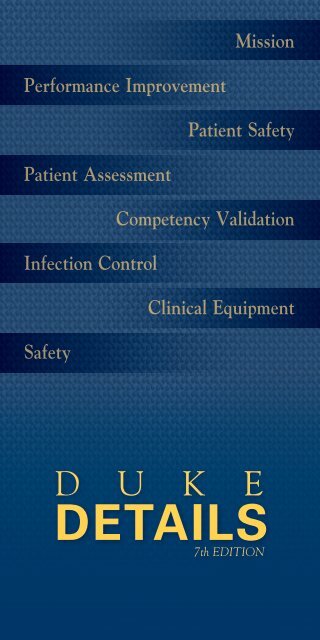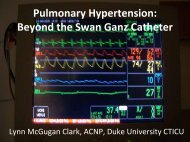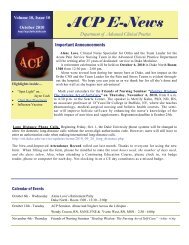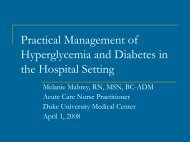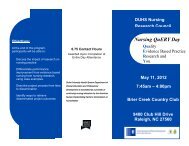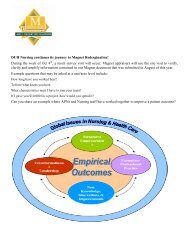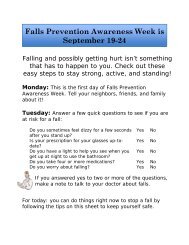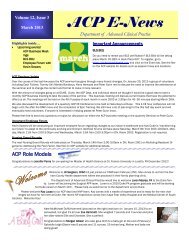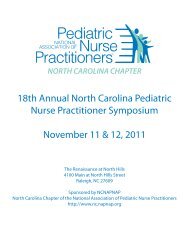D u k e Details - Advanced Clinical Practice - Duke University
D u k e Details - Advanced Clinical Practice - Duke University
D u k e Details - Advanced Clinical Practice - Duke University
You also want an ePaper? Increase the reach of your titles
YUMPU automatically turns print PDFs into web optimized ePapers that Google loves.
sWhat are <strong>Duke</strong> <strong>University</strong> Hospital’sMission, Vision and Values?MISSION: Why are we here?To serve our patients and the global community byproviding the finest clinical integration of patientcare, education and research while respecting theneeds of the human spirit.VISION: Where are we going?To be the leading academic health services providerby delivering high quality, innovative responses tosociety’s changing healthcare needs.VALUES: How are we going to get there?• Excellence & Innovation• Safety & Quality• Teamwork & Diversity• Learning & LeadershipMission, Vision, and Values3
(DUHS) Employee IntranetWhat can I find on the employee intranet?You can find a wealth of information on the <strong>Duke</strong><strong>University</strong> Health System (DUHS) employee intranetto assist you in performing your job. You should alsobe comfortable with accessing and exploring theseand other items on the intranet:• Policies & Manuals – some examples include• DUH Policy & Procedure• Health System Policies• Infection Control Policies• DUH Nursing Process and StructureStandards• Human Resources (HR) Policies and Manuals• Lippincott Manual• Pharmacy Formulary• The Joint Commission standards• In House First Call Functional Pagers• Information on the latest initiatives• Employment opportunities• Patient satisfaction survey results• DUHS resources• Safety Reporting System (SRS)Hard copies of the policy manuals & Material Safety DataSheets (MSDS) resources are available in the OperationsAdministrators’ office in 1300 <strong>Duke</strong> North.Where do I find the employee intranet?http://staff.dukehealth.org/4s
sHow is DUH continuing to enhance theCulture of Patient Safety?Safe Choices is a one day retreat for frontline staffand managers led by Kevin Sowers, CEO of DUHand Mary Ann Fuchs CNO of DUH and DUHS toexamine choices people make in their daily lives, atwork and outside of work that may put themselvesor others at risk for harm. The workshop includes apowerful patient story, an examination of real eventsthat occurred at DUH, and an introduction to “JustCulture”. It is a mix of didactic and small group work.The term “Just Culture” refers to a safety-supportivesystem of shared accountability where DUH isaccountable for the systems they have designed andfor supporting the safe choices of patients, visitors,and staff. Staff, in turn, are accountable for thequality of their choices – knowing that we cannotwill our selves to be perfect, but we can strive tomake the best possible choices. Just Culture hasbeen implemented as a model for the investigationand response to events.An annual Patient Safety Culture Survey isconducted to measure the progress toward developinga culture of Patient Safety. Survey results areanalyzed and reported to DUH Senior Leadershipand the safety and quality committees. DUH setspriorities for new initiatives based on survey results.Executive Patient Safety Walkrounds providesan opportunity for staff and patients/families tocommunicate identified risks with DUH seniorleadership; it allows leadership to see and hear thesafety concerns; and together actions are taken andtracked through resolution of the issues identified.Patient Safety and Just Culture5
How does <strong>Duke</strong> integrate Patient SafetyBest <strong>Practice</strong>s into clinical practice?Improve the Accuracy of PatientIdentificationNational Patient Safety Goals• Inpatient identifiers – Use patient’s fullname and medical record number• Outpatient identifiers – Use patient’sfull name and date of birth(Patient’s room number or location is never usedas an identifier.)Check at least two patient identifiers when providingcare, treatment or services and actively involve thepatient and family in the identification process. (Seestaff intranet DUH Patient Identification Procedure foradditional information.)A two person verification process is required prior toinitiating the transfusion of blood or a blood product.(See staff intranet DUH Transfusion of a Blood ProductProcedure for additional information.)Label containers for blood and other specimens in thepresence of the patient.Improve the Effectiveness ofCommunication Among CaregiversReport critical results of tests and diagnosticprocedures on a timely basisDUH Critical Test and Diagnostic Procedures Policydefines the tests/procedures, and the management ofreporting identified results from tests/procedures forappropriate clinical patient management.6s
sImprove the Safety of Using MedicationsReduce the likelihood of patient harm associatedwith the use of anticoagulation.DUH Anticoagulant Policy outlines the safe practicesrelated to medication ordering, INR monitoring, staffeducation, patient teaching, and managing food anddrug interactions.A subcommittee of the Pharmacy and Therapeutics(P&T) Committee evaluates safe practices andmeasures effectiveness of actions through analysisof SRS and surveillance data.Reduce the likelihood of patient harm associatedwith the use of anticoagulation therapy by usingCPOE advisors (dosing requirements) and standardizedpatient education materials.Identify the safety risk inherent inpatient’s being treated for emotionalor behavioral disorders (those admittedto Williams Unit)Identify patients at risk for suicidePerform a risk assessment on any patient admitted toa psychiatric unit. Use standard procedure for searchof patient and care with a suicide risk. Dischargeteaching includes the provision of resources forpatients and families on suicide prevention.National Patient Safety Goals7
Involve patients and their families in thepatient’s care as a safety strategy• Engage patients and families in discussionsabout their care and concerns especially forhand hygiene practices, respiratory hygienepractices and infection control practices, asindicated.National Patient Safety Goals• Encourage patients to view the “Partners inSafety: Keeping You Safe” video available onPatient Education Channel 44 or on the hospitalwebsite. The films are available in English andSpanish.Reduce the Risk of Health Care AssociatedInfectionsDUH’s hand hygiene policy complies with theCenter for Disease Control’s (CDC) or World HealthOrganization’s requirements:• Wash hands before and after patient contact.• Alcohol based hand rubs can be used if handsare not visibly soiled.• Use antimicrobial soap and water and wash for15 seconds if hands are visibly soiled.• Do not use alcohol based hand rubs for patientswho have Clostridium difficile (C-difficile).• Include the patient and family in HandHygiene Campaign.• Identify the Hand Hygiene compliance rate foryour work area._ ________________________________________8s
sImprove the recognition and responseto changes in patient’s condition.• DUH has rapid response teams (RRTs), pediatricand adult code teams, and first responders. Call115 for inpatient adult or pediatric RRTs or codeteam assistance.• Activate the first responder system for ambulatorypatients and/or visitors by calling 911 froma <strong>Duke</strong> phone.Implement evidence-based practices toprevent healthcare associated infectionsdue to multidrug resistant organisms inthe hospital• Central line associated bloodstream infections• Educate staff who are involved in managingcentral lines annually• Educate patient and family• Implement policies to reduce the risk basedon evidence-based standards• Use a catheter checklist and standardizedprotocol for insertions• Avoid femoral vein insertion, if possible• Use standardized kit• Use chlorhexidine-based antiseptic• Provide infection rate data as shown onBSC storyboards • Surgical site infections• Develop and implement policies aimedat infection prevention• Educate staff and physician partners aboutthe importance of prevention, annually• Educate patients and families• Conduct periodic risk assessments• Monitor surgical site infection ratesfor cardiothoracic, neurosurgical andorthopedicsNational Patient Safety Goals9
Prohibited Abbreviationsin the medical recordNational Patient Safety GoalsQ.D.Q.O.D.UIUAvoidMSO4 or MSMgSO4RecommendedWrite “daily”Write “every other day”Write “units”Write “international unit”Write “morphine sulfate”Write “magnesium’sulfate”µg Write “micrograms”or “mcg”TIWccA trailing zero (2.0)A naked decimalpoint (.2)Abbreviations ofchemotherapeuticagentsWrite “three times aweek”Write “ml” or “milliliters”Write 2 mgWrite 0.2mgWrite approved genericname10s
sAccurately and Completely ReconcileMedications Across the Continuumof CareMedication reconciliation is the process ofcomparing the patient’s current list of prescribedmedications against the medications received inthe previous care setting when a patient is admitted,transferred from one level of care or service toanother, discharged or on outpatient encounter,including settings where medications are minimallyused or used for short durations.On inpatient admission:• The nurse & prescriber collect and documentcomplete medication histories independently.• The pharmacist compares medication historiesagainst one another and admission orders andreconciles discrepancies with the prescriber.• On transfer, reconciliation occurs with acceptanceof transfer orders. Transfer is anytimethe patient changes service, setting, provideror level of care and new medication ordersare written.• On discharge, the focus is on reconcilingthe pre-admission list and inpatient list.Communicate a complete current medicationlist to the patient and to the next care providerat discharge.On outpatient encounter, the intake person• Reviews and modifies patient medication list.• The physician reviews with the patient andupdates medications as needed.• Communicate a complete medication list tothe patient and the next care provider at theend of the encounter.National Patient Safety Goals11
Time-OutWhat is a TIME-OUT in a health caresetting?Time-Out: A verification process that occurs priorto the start of an invasive or surgical procedure inorder to confirm correct patient, site, procedure usingactive communication between all members of thecare team.All members of the care team – proceduralists(MD, NP or PA), nursing staff & anesthesia provider(if present) and techs will verbally confirm at aminimum:• Correct Patient using two identifiers• Correct Site and Side• Correct ProcedureFor additional information, refer to the staff intranet“Procedure for Time-Out”.12s
sHow do we measure our success?At DUH, we measure our success in four key areas:Quality and Patient Safety, Customer, Work Cultureand Finance.These areas combine to form the BalancedScorecard (BSC), The BSC is the tool DUH uses tolink long-term goals with short-term effects.• It includes priorities set by hospital leadershipto support our mission, vision and values.• The priorities are reviewed each year.• The priorities are used to define goalsfor each clinical service unit (CSU) anddepartmentThe Balanced Scorecard four quadrants are:Quality & Patient Safety:“What type of care are we giving our patients?”Customer:“How satisfied are the patients with the carethey receive?”Work Culture:“What type of work environment do we provideour employees?”Finances:“How well do we use our resources?”Performance Improvement (PI) and Balanced Scorecard13
Performance Improvement (PI) and Balanced Scorecard14What are the DUH priorities for fiscalyear 2010?sQuality & Patient Safety QuadrantPriorities:• Achieve excellent patient outcomes bycontinuing to be a top performer forevidence-based care• Provide a safe patient care environment• Be available for patients who need our careCustomer BSC Quadrant Priorities:• Achieve a high level of patient satisfactionthroughout the care continuumWork Culture BSC Quadrant Priorities:• Maintain a high-quality workforce that iscommitted, motivated, and equipped to provideexcellent patient care• Support the engagement of physicianpartners to enhance processes• Promote diversity within our leadership teamFinance BSC Quadrant Priorities:• Effectively manage cost and revenue cycleto meet targeted operating income• Deliver targeted growth and businessdevelopmentHow do we track our progress? Critical SuccessFactors and Key Performance Indicators are ways tomeasure the progress and are reviewed each year.What is a Critical Success Factors (CSF)?• A CSF is a measure that is extremelyimportant to the success of the hospital• It is linked to the DUH Priorities on the BSCWhat is a Key Performance Indicator?• Key performance indicators are all the othermeasures on the BSC.
sWhat does Performance Improvementmean at <strong>Duke</strong>?DUH uses the 5-step DMAIC (Define, Measure,Analyze, Improve and Control) process to guide ateam from project inception through completion.DMAIC is a data-driven approach to analyzing andimproving performance. Performance improvementprojects are aligned with hospital priorities.Define ➠ Ë Define the problemMeasure ➠ Collect data aboutthe problemAnalyze ➠ Find the cause ofthe problemImprove ➠ Make the changes toeliminate problemControl ➠ Maintain effectivenessof changePerformance Improvement (PI) and Balanced Scorecard15
Performance Improvement (PI) and Balanced ScorecardWhere can I find out about the BSCand Performance Improvement effortsin my area?Throughout DUH there are storyboards that shareperformance improvement activities. They areupdated monthly and link local PI efforts with DUHpriorities, using the BSC format.• Look for your area storyboard• Contact your manager or local PIrepresentative• Visit the Performance Services website athttp://psweb.dukehealth.orgWhat are the current PI project(s) foryour area?________________________________________________________________________________________________________________________________________________________________________My area project(s) include _ ______________________________________________________________What work has been done to improve theperformance?_ __________________________________________________________________________________________________________________16s
sHow do we know if our patients aresatisfied with their experiences?DUH surveys our patients’ satisfaction levels toidentify ways to improve the quality of services andthe care we provide. A random sample of patientsfrom the following areas receive surveys: Inpatient,Ambulatory Surgery, Emergency Department,hospital-sponsored outpatient tests and treatments(e.g. radiology, PT/OT), behavioral health, andhospital-based clinics.The results of these surveys are regularly communicatedto hospital leadership and managementwho communicate the results to staff. PerformanceServices staff and other employees establish teamsto review the data and develop performanceimprovement initiatives to improve performance.DUH priority patient satisfaction areas of opportunityfor us to focus on include:• Meeting a patient’s emotional and spiritualneeds.• Informing patients and families about theircare and any delays they may experience.• Including patients in decisions regardingtheir treatment.• Responding to patients and families’concerns and complaints.• Informing patients and families about thedischarge process.Some sample initiatives you may see in your areainclude:• Leadership and Charge RN Rounding• Patient Admission Folder and DischargeEnvelopes• Patient Communication Boards• Real Time Surveys• Strive for Five ProgramFind out the most recent patient satisfaction surveyresults for your area and/or the hospital.Patient Satisfaction17
Patient Visitor Relations and Service RecoveryWho do you contact when a patient’sexpectations are not met (ServiceRecovery)?It is the responsibility of every <strong>Duke</strong> Hospitalemployee to provide world-class service. Whencustomer expectations or standards are not met,every effort will be made to assure a remedy oran optimum outcome. Address the concernimmediately using the HEART protocol.HEART ProtocolHear the patientEmpathizeApologizeRespondThankPatient/family complaints/grievances may be referredto the department of Patient Visitor Relations at681-2020.All grievances must be responded to in writingwithin 7 days acknowledging concern. A writtenresolution must follow within 30 days of receipt ofconcern. Staff members are expected to comply withthis standard when asked for assistance in resolvingand responding to grievances. Since we also like tohear good news, compliments from patients and theirfamilies can also be referred to this number.18s
sWhat is a sentinel event?A sentinel event at DUH is an unexpected patientoccurrence involving death or serious physical orpsychological injury or the risk thereof:• Not a known risk of disease state ortreatment• Commonly due to a deviation from standard ofpractice• Includes the death or loss of function due tohealthcare associated infection.How does the hospital respond to asentinel event?Once the Sentinel Event Senior Team designates anevent as sentinel, a leader & members of a root causeanalysis task force are identified. The interdisciplinarytask force completes the root cause analysis within45 days including an action plan to address the rootcauses identified. The lessons learned are sharedbroadly throughout the hospital and effectiveness ofthe actions are measured over a defined timeframe.Sentinel Events19
Who is responsible for reporting concernsrelated to patient or employee safety?EVERYONE!Safety Reporting System (SRS)At DUH, you may report through the SafetyReporting System (SRS). The SRS is the primarymeans of reporting any safety concern including:• Patient Incidents• Errors and near misses,• Occupational safety concerns or accidents(report within 24 hours)• Visitor incidents or concerns• Patient incidents related to a clinical studyThe SRS can be found on the staff intranet or byclicking on the Safety Reporting System Icon orShortcut on the PIN workstations.If you are injured at work, or develop an illness thatyou believe to be related to your job, report it bythe end of your shift by completing the informationwithin the SRS.Additional information is available at: http://www.hr.duke.edu/workcomp/index.html20s
sWhat should be included in an SRSreport?1. State the facts as you know them2. Describe the issue completely3. Do not blame an individual(s)4. Reporting can be anonymous, but rememberwe can only provide you feedback of ourfindings if you identify yourself by name5. If you have recommendations for preventingthis from happening again, share it inthe report.Information you share in the SRS system is valuableand confidential. It allows us to evaluate the circumstancesaround events you report and developstrategies for prevention of reoccurrences.Communicate your concern to your supervisor, orcontact the Patient Safety Officer, Risk Management,Environmental Safety or The Joint Commission (TJC).You may contact The Joint Commission (TJC), ourprimary accrediting body, at 1-800-994-6610 or theTJC website http://www.jointcommission.orgNo one is punished for reporting what he or shehonestly believes is a safety concern.For events that involve ...• Equipment or infusion pumps – sequesterand mark the equipment and call clinicalengineering.• Medication events associated with patientharm should be called to medication safetypager – 970-2494• Any drug product whose potency or sterilityis in question should be bagged, labeledand released to either Risk Management orMedication Safety.Safety Reporting System (SRS)21
Interpreters and Patient RightsHow do our patient’s learn of their rights?Patient Rights: Every inpatient room has a copy ofthe “Guide to Patient & Visitor Services” (English andSpanish). This booklet provides information usefulto the patient throughout his/her hospitalizationincluding a statement of the patient’s rights andresponsibilities while hospitalized. Inpatients alsoreceive a copy of their rights as part of the admissionprocess. Outpatients also receive notification of theirrights and responsibilities through the posting of“Our Commitment to You” in strategic locationsthroughout the hospital and through flyers that aredistributed during the registration process.For patients with communication barriers, patientrights are available in Braille and on audiotape inEnglish and Spanish.For assistance with medical interpretationservices 24 hours a day, 7 days a week, contact681-3007. Assistance is available in Spanish, Arabic,French, & Berber. Other select languages areavailable by appointment. To schedule a futureappointment with an interpreter, visit the departmentwebsite through the <strong>Duke</strong> Staff Intranet Quick Linksand submit your request for an interpreter. You canalso submit a document for translation through thewebsite.CyraCom International provides over-the-phoneinterpreting services for languages not provided bythe IPS. CyraCom blue phones are installed in manyareas of the hospital for easy access to a CyraCominterpreter.For hearing impaired, interpreters or services forvisually impaired, call 681-2020.22s
sWhat are key points regarding how wemanage Advance Directives?Advance Directives (AD):• Asked upon admission for all adults.• If the patient has an advance directive, thismust be indicated on the Universal AdmissionAssessment Form, and a copy of the patient’sadvance directive must be placed in the legalsection of the patient’s medical record.• With inpatient admissions, if the patient hasan advanced directive, but does not havethe document with them, the patient maycomplete another document.• If the patient does not have an advancedirective, the patient must be asked if theywould be interested in additional informationabout advance directives.• AD forms are available on inpatient units, andoutpatient clinics or may be ordered.• If the patient would like to complete an ADor has questions, please contact Patient &Visitor Relations (681-2020), or PastoralServices (970-8215) for assistance withexecuting documents.• Administrative support staff including FinancialCare Counselors and HUCs that have completedthe notary training will be able to notarizeAdvance Directives.Mental Health Advance Instruction (MHAI): Alegal document allowing a person to give directionabout future mental health care or to designateanother person(s) to make medical mental healthdecisions if he/she should lose decision makingcapacity. Adult patients with active mental healthdiagnoses admitted to medical/surgical areas will beasked if they have a MHAI or if they wish informationabout it by the admitting nurse.Advance Directives and Instructions23
Resuscitation, End-of-Life Care, and EthicsHow is a limited cardiopulmonaryresuscitation order communicated?Unless otherwise specified in writing on the Doctor’sOrder Sheet or on the Life Support Order Sheet(#M0174) in the patient’s medical record, fullresuscitation procedures will be initiated for allpatients in respiratory or cardiac arrest.In accordance with the Doctor’s Orders to LimitCardiopulmonary Resuscitation (DNR) Procedure(available on intranet), an attending physician mayissue an order to not resuscitate a patient or to limitresuscitation efforts to specifically defined measures.A verbal order needs a co-signature within 24 hours.Under NC’s Right to a Natural Death law, care may bewithheld or withdrawn on patients meeting specificdefined criteria. The DUHS Right to a Natural DeathProcedure outlines these criteria and the procedurethat must be followed in order to adhere to the law(available on intranet).Ethical Concerns: Any patient, family member orstaff member involved with a patient’s care cancontact the <strong>Clinical</strong> Ethics Consultation Servicefor help with resolving ethical dilemmas. Call970-8209 to arrange a consult.24s
sWhat can you do to protect patientconfidentiality?Steps you take to protect patient confidentiality:• Only access the patient records needed to performyour work/duties as it relates to treatment,payment or operations of the hospital.• Close chart boxes when not in use.• Activate screen saver when computer not inuse.• List patients only by last name, first initial, and/or coded diagnosis in areas where visitorsfrequent.• Avoid posting information on patients’ doorthat discloses diagnoses or treatments.• Do not discuss patient information in publicareas, including hallways, cafeterias andelevators.• Permit access to patient information only bythose involved in the patient’s care. Directvisitors to the Information Desk.• Protect computer password(s). Don’t share itwith anyone. Never write it down. Don’t say italoud. Don’t email it.• Include confidentiality notice on all faxesinvolving patient information.• Dispose of protected health information in“Shred It” containers for destruction.• Do not share patient information on socialnetworking sites such as Facebook, MySpace,Twitter, etc. Do not “friend” patients.For more details, refer to <strong>Duke</strong> <strong>University</strong> MedicalCenter Confidentiality Agreement and the on-lineHealth System Policy Manual.Confidentiality25
Fall PreventionWhat actions do we take to reduce therisk of patient harm resulting from inpatient falls?Assess falls risk on admission or ambulatory check inand reassess every shift, or on transfer to another unit,or with change in care nurse.Assessment to include:• On admission, fall(s) in the last 12 monthsand every shift/visit• Alteration in mental status: confused, disoriented,impaired memory, unable to followcommands• Ability to ambulate to bathroom and back(excludes assistance with equipment, i.e., IVpole)• Other reasons patient may be at risk: medications– new or change in dose, blindness,incontinence, etc.Conduct safety checks every 2 hours on ALLinpatients. Remember the 5 Ps (Protect,Possessions, Pain, Potty and Partner) withyour safety checks.PROTECT• Keep bed in low position with wheels locked• Have 3 side rails up with rail at foot of bed onside near bathroom in down position (adults)or if < 4 yrs old, in a crib all 4 siderails must beup, or cognitively or physically impaired• Place IV pole on side of bed near bathroom,when possible• Keep path to bathroom clear and unobstructed• NIght light on at night• Use nonskid slippers26s
s• Schedule laxatives/diuretics between9a-5p, when possible• Use patient lifts and transfer devices whenneededPOSSESSIONS• Keep assistive devices (cane, walker), necessities(glasses, hearing aid, remote control, drinks,urinal, drink), AND call bell in easy reach• Orient patient to environmentPAIN• Provide optimal comfort: pain or symptommanagementPOTTY• TAKE patient to bathroom every 2 hours• WAIT outside bathroom to return patient tobed/chairPARTNER• Educate family to notify care nurse when theyleave the room• Educate patient to CALL for assistance• Collaborate with pharmacy to determine medswith increased riskFor the patient that is identified at risk when assessed– Implement the falls plan of care!• Place a FAllS armband on patient• Place falling star label with patient’s name atdoor and on the main desk name board• Review medications for new meds, changes indose, etc that could increase riskFall Prevention27
Infection ControlHow do your actions of practicinginfection prevention promote patientsafety?Infection Control practices include:• Adherence to hand hygiene• Following precautions• Following isolation policies• Using aseptic technique for central venousline insertion• Always wearing appropriate PersonalProtective Equipment (PPE)• Following construction guidelines• Reducing health care associated infections• Health care workers getting influenzavaccines yearly, and• Following respiratory etiquette for patientsand staffHandwashing is the single most effective methodto prevent the transmission of infection. Wash for15 seconds using hospital supplied antimicrobialsoap and water. An alcohol-based waterless agent,located in strategic locations in patient care areasand throughout <strong>Duke</strong> North and South, can be usedinstead of regular handwashing in most instances.Recent studies have shown that the waterlessalcohol agents are effective against resistant organismssuch as MRSA and VRE. To be effective, it mustbe rubbed on the hands for at least 15 seconds.The alcohol agents can not be used for patientswith Clostridium Difficile or when visible soiling is evident.In such instances, hands must be washed withsoap & water.28s
sWhat types of precautions are usedat DUH?Standard precautions should be used with allpatients when the possibility of contact with bloodor body fluids exists.Isolation:• Contact isolation is used for patients withresistant organisms such as MRSA and VRE.On pediatric services, the precaution methodis also used for Adenovirus and RespiratorySynctival Virus (RSV). Gowns and gloves arethe minimal protective equipment needed.• Droplet isolation is used for diseases spreadthrough the droplet route including meningitis,pertussis and Influenza. Patients are placed in aprivate room and a regular surgical mask is usedwhen entering the room.• Airborne isolation is used for patients withsymptoms suspicious of tuberculosis andpatients with varicella zoster. Wear N95 maskto enter patient’s room. Fit testing is requiredto use the N95 particulate respirator mask. Ifyou have not been fit-tested, you should use apowered air purifying respirator (PAPR).• Strict Precautions are used for patientswith highly resistant organisms such as VISA/VRSA and KPCs. Use gown and gloves to enterpatient’s room, and a surgical mask whenindicated.Can a nurse initiate isolation?A nurse can initiate isolation if:1. The patient has signs or symptoms of acommunicable disease such as Tuberculosis,Varicella Zoster, etc., or2. A patient has a history of a resistant organismsuch as MRSA or VRE, or3. A patient has a culture result indicative of aresistant organism.The nurse should consult with the physicianbefore writing the order for the specific isolationprecaution.Infection Control – Isolation29
What additional safeguards are requiredwhen providing care to TB patients?Infection Control – Isolation and Construction• Move patient to a designated room, ifpossible, and notify Biological Safety orInfection Control.• House patient in a negative pressureisolation room that has a “AirbornePrecautions Isolation” sign posted on the door.• PPD Skin testing is required annually based onwork location• TB patients are provided a surgical mask to wearwhen outside of room.Are you aware that there is an interdisciplinaryteam in place to evaluate/conduct risk assessments related toconstruction work?Members of Infection Control, Engineering &Operations, and Biological Safety review plans for constructionprojects to ensure that patients & employeesare safe from risks associated withconstruction.Construction:Inadvertent exposure to environmental pathogensduring construction can result in adverse outcomesfor patients and cause illness in health care workers.We can minimize these exposures by:• Maintaining secure barriers• Routing patients away from construction area• Maintaining appropriate ventilation• Adherence to dust control measures• Cleaning work zone entrances daily• Providing construction workers withdesignated entrances, corridors andelevators.30s
sWhat are acceptable temperature rangesfor refrigerators and freezers that supportpatient care?The temperature of refrigerators and freezers thatsupport patient care must be monitored at least dailyto assure appropriate temperature is maintaineddepending on the contents of the refrigerator orfreezer. Daily temperatures are to be monitored.Monitoring is either performed manually or electronically.It is the individual area’s responsibility to knowwho is responsible for the monitoring, and what theprocess is if the temperature is noted to be out ofrange.If a temperature is found to be out of range, appropriateactions will be taken and properly documented.The actions depend on the contents of the refrigerator.Pharmacy, Engineering and Operations (E&O)and/or Food Services will be notified, as appropriate.For additional information, refer to the “RefrigeratorTemperature Control Policy”.Refrigerators and Freezers31
How do you know if the preventive maintenanceinspection has been completedon clinical equipment?<strong>Clinical</strong> Engineering performs periodic preventivemaintenance inspections on certain types ofclinical equipment. Some low risk equipment(e.g. battery-operated equipment) does not requirethis inspection.At a minimum, the <strong>Clinical</strong> EquipmentMaintenance sticker lists the technician completingthe inspection and the next time the equipmentrequires a preventive maintenance check.<strong>Clinical</strong> EquipmentThe <strong>Clinical</strong> Engineering Website identifies sources forreplacement equipment in the event of equipmentmalfunction and defines the process used to haveequipment function evaluated/repaired.www.duhsclinicalengineering.org32s
sHow do you know the hazardousmaterials you work with?Information about the chemicals you use on yourjob can be found on the:• label-name of the chemical, appropriatehazard warning and the name and address ofthe manufacturer.• MSDS (Material Safety Data Sheet)-refer to inan event of exposure and/or spill. MSDS sheetscontain detailed health, safety and environmentalinformation pertaining to the specificchemical.Every department has access to MSDS sheets, theMSDS sheet can also be located through an onlinesearch of Micromedex. Google chemical name andMSDS.I can access MSDS sheets at__________________________________________Chemical spill response:• If comfortable with knowledge of substance:clean up using recommended safety measures• If uncomfortable with knowledge of substance:refer to the MSDS and/or, if locatedon campus, activate the spill response team bycalling 911.• If chemotherapy: use the chemo spill kitavailable in high use areas.Safety33
Emergency ManagementEmergency Management (EM) Plan: Eacharea is required to have its own detailed unit subplanto support the goals and objectives of the DUH EMPlan. <strong>Duke</strong> has established “Codes” to describecertain disaster scenarios (e.g. fire, security threat,hazardous materials event, severe weather, etc.) Inthe event of a disaster situation, an overhead pageannouncing the code will be made. Refer to the“Emergency Codes Know- What to Do” cardbehind your nametag. Refer to your unit ordepartment’s subplan to determine your role.Staff should also ensure that their own individual andfamily preparedness plans are in place.RACE response to a fire:Remove persons in immediate dangerActivate the fire alarm and Dial 911Close all doorsExtinguish the fire“PULL the Pin, Call it in” – Dial 911PASS to use a fire extinguisher:Pull the pinAim at the base of the fireSqueeze the handlesSweep at the base of the fireThe fire alarm pull station(s) in my area arelocated: ___________________________________My area’s floor evacuation map/plan is located:__________________________________________The medical gas shut off valves for my area arelocated: ___________________________________Determine your role in the shutoff of medical gasesby referring to the <strong>Duke</strong> Hospital Policy.34s
sGuards (sometimes referred to as forensic staff)accompanying patients, receive training on how toconduct themselves at <strong>Duke</strong> <strong>University</strong> Hospital.Topics include:• Interacting with patients• Hospital chain of command• Safety issues• Actions to take if they witness a change in thepatients conditionRefer to the online Patients in Custody of LawEnforcement Authority procedure in the DUH Policymanual.Forensic Staff35
Are you aware that <strong>Duke</strong> Hospital has asafe needle device program?The major goal of this program is to identify and stocksafer sharps for use in the hospital to reduce the incidenceof needle sticks to our employees. It includestraining on the availability and use of approved safetydevices where appropriate for work responsibilities.All employees are required to use safety devices whensafety devices are available. Exceptions to this mustbe approved through Biological Safety.Note: If you should experience a needle stick or other exposure toblood or body fluids, call the hotline:Biological Safety<strong>Duke</strong> Hospital Onsite Locations – 115: Offsite – 684-8115.Complete a report using the Safety Reporting System.What is the procedure for disposing ofregulated medical waste found in theinpatient and clinic areas?Sharps – including needles, syringes with attachedneedles, slides and cover slips are to be placed in thepuncture-resistant needlebox containers located inevery patient room, medication cart and code bluecart.“Bulk” blood/body fluids (20 ml or greater) suchas those found in suction liners, blood bags, pleurevacsand other drainage containers are to be placedin the biohazard containers located in the soiledequipment rooms.Contaminated items that would release blood orbody fluids in a liquid state when compressed, suchas soaked surgical sponges, are to be placed in thebiohazard containers.Other regulated waste according to DUH MedicalWaste Management Policy located on the intranet.Note: Solid waste from patient rooms (used gloves, masks, disposablegowns, gauze, etc.) are not regulated medical waste and shouldbe disposed of in the regular leak proof plastic trash bag for transportand disposal.36s
sCompetency validation occurs in one of twoways:• Credentialed Staff: Upon appointment,MDs, PAs, CRNAs, NPs, CNMs, and other specificdisciplines apply for privileges to deliver careto patients at <strong>Duke</strong> <strong>University</strong> Hospital. Theseprivileges are renewed every 2 years followingan ongoing review of the practitioner’s performance.Privileges held by these practitionerscan be verified on the DUHS intranet, <strong>Clinical</strong>Resources section titled “DUMC Staff Privileges”.• Non-credentialed Staff:• Orientation: Initial competency validationoccurs by observing staff perform assignedjob duties safely. Some duties requiresuccessful completion of test.• Performance Appraisal: Competencyvalidation occurs on an ongoing basis andannually within the first quarter of the fiscalyear (July-Sept).Population-Specific Competencies:Non-credentialed staff with jobs involving routinepatient contact for therapeutic purposes (e.g. nursingassistants, respiratory therapists, registered nurses,clinical pharmacists) also require the validation ofpopulation-specific competencies during orientationand annually thereafter through the performanceappraisal process.Examples of population specific competencies:• Effectively communicates using age appropriatetechniques• Maintains a safe environment appropriate topatient age.• Assures that procedures/treatments areappropriate for age and/or weight of patient• Uses equipment appropriate to the age &weight of the patient.Competency Validation37
Competency ValidationThe criteria for these are job-specific. Direct observation,documentation audits, peer review, and/orcritical thinking scenarios are used to complete thevalidations.Educational and performance management activitiesshould incorporate age-specific information whenappropriate to the job responsibilities.Area-specific competencies: Depending onyour area of assignment, your job may require specialcompetencies. Examples:• Food Temperature Determination• EKG Interpretation• Database Management• Basic/<strong>Advanced</strong> Cardiac Life Support• Nursing Core Competencies: Skin Care, Pain, Pt.Monitoring, Medication, & IV Therapy• Age-Specific Competencies• Competencies addressing Advisory Statementsfor <strong>Advanced</strong> Nursing Skills (NC Board ofNursing)• Population-Specific Competencies38s
sCoworkers’ competencies may be identified ina number of ways.• Individuals record achievement, competenceand participation in education programs on theIndividual Education Record or Ed Track.• Managers or Directors record competenceachievement in a database & in the employee’spersonnel file.• A list of credentialed staff and their privileges(e.g. physicians, NPs, PAs, CRNAs) is availableon the DUHS intranet in the <strong>Clinical</strong> Resources,<strong>Clinical</strong> References section titled DUMC StaffPrivileges.• If neither of these is available, you cancontact the individual’s supervisor or anOperations Administrator (OA) for assistance.Per diem and contract staff (e.g. agency, travelers)also complete an orientation to DUH and to theirspecific job duties. Their competencies, inclusiveof population-specific competencies, are validatedduring orientation and their performance is periodicallyevaluated.Competency Validation39
What are the critical elements of aninpatient assessment?Patient Assessment40All disciplines involved in patient care work togetherto perform a comprehensive patient assessmentthrough the collection and analysis of data. Thepatient is assessed upon encounter/admission andthroughout hospitalization. These interdisciplinaryassessment findings are used to make decisions aboutthe patient’s plan of care.For pediatric patients: developmental age, headcircumference (
sAssessment data collected by the disciplinesinvolved in the patient’s care are reviewed by eachdiscipline involved to identify the priorities of care.Patient acute and chronic problems, and problemsidentified but not to be addressed, are documentedon the Problem/Procedure Summary form (M01A) orin eBrowser.Rounds and care planning/discharge conferencesalso offer opportunities for information sharing andcollaboration. Those participating in these discussions& the outcomes are documented in the patientrecord.Interdisciplinary clinical pathways are used onpatients with specific diagnoses and often includethe plan of care.Some examples of standards used to develop thepatient plan of care include:• American College of Surgeons• American Association of Critical Care Nurses• <strong>Duke</strong>-authored policies/protocols• American Dietetic AssociationThe patient/family’s education needs, abilities,preferences, readiness to learn and barriers to learning(e.g. literacy, language) are assessed and documented.The patient’s interdisciplinary educational planmay be discussed during patient care rounds andpatient care/discharge planning conferences. Patientand family educational activities and their responsesto those activities are recorded in the medical record.Additional online information located on the PatientEducation section of the staff intranet.Interdisciplinary Plan of Care41
sAll members of the healthcare team monitor for theintended and unintended effects of medicationsand provide input into the medication plan.Documentation of patient responses to medicationscan be found on the flowsheet, MAR or progressnotes in the patient record.Healthcare team members monitor the patient’sresponse to the first dose(s) of a new medication.Follow the Six Rights of MedicationAdministration1. Right Patient2. Right Drug3. Right Dose4. Right Time5. Right Route6. Right ResponseAll medications are securely stored. Steps to maximizesecure storage include:• Protect your password(s).• Lock all medication carts, medication cabinets,and automatic dispensing cabinets. Closedrawers before walking away. Medicationcarts on the inpatient units lock down 1 minutefollowing authorized access.• Narcotics & other controlled substances arekept in a locked storage container. Verifycontrolled drug inventory after withdrawaland per policy• Emergency medications are kept secure inCode Blue carts. Document every shift that thelock integrity has not been compromised andthe cart is current according to its expirationdate.• Call maintenance (684-3232) immediatelywhen medication carts (flashing lights), storagecabinets and refrigerators do not lock properly.Medication Management43
sLabel all medications, medication containers orother solutions on and off the sterile field in theperioperative and other procedural areas with thefollowing:• Medication Name• Strength• Quantity• Diluent and Volume• Preparation Date• Expiration date if not used within 24 hours• Expiration time when expiration occurs in lessthan 24 hours.Sterile markers and labels are available in automaticdispensing cabinets. All sterile trays with medsinclude a sterile marker and label for labelingsyringes, etc. Radiology labels contrast containers.Medication Management45
sWhat to consider when a patient needsto be restrained or secluded?All decisions to restrain or seclude are based uponindividual patient assessment. Alternatives areattempted and documented prior to restraining/secluding, and the least restrictive, yet effective,method is always used.Patients may be restrained to maintain therapiesor deliver treatment associated with a medical/surgical condition that, if left untreated, wouldmedically compromise the patient and/or to preventthe patient from unintentionally harming him/herself(e.g. med/surg. indication)ORIn an emergency when there is imminent risk of thepatient harming self or others (e.g. violent behavior)Restraint or seclusion interventions are initiated byan MD, NP, or PA order unless it is an emergency. Inthat case, an RN may initiate the intervention, obtaina verbal and get cosignature from the MD, NP, or PAat a later time (within one hour for behavior management;24 hours for med/surg).All restraint/seclusion orders are time-limited. Forbehavior management, the duration of the order isage-dependent. For all other patients, maximumtime limit is one day. Any staff member who hasparticipated in training and has had their competencyvalidated may apply restraints.Patients who are restrained for med/surg. indicationsmust be observed at least once an hourand recorded on flowsheet. Patients restrained orsecluded for behavioral management reasons mustbe observed continuously and for 30 minutes afterthe termination of the intervention and assessmentdocumented every 15 minutes. These observationsare documented on the “Seclusion and BehavioralManagement Flowsheet” or in clinical area-specificdocumentation system.Restraints and Seclusion47
Restraints and SeclusionThe patient’s care needs (nutrition, elimination,repositioning, range of motion, neuro and circulationchecks) must be attended to at least once every2 hours and documented.The RN performs the inpatient assessment of therestrained/secluded patient for continued need.This assessment is performed at a minimum every 2hours for med/surg. indications and every 15 minutesfor behavior management indications. Theassessment findings and the patient’s response tothe restraint/seclusion intervention is documented.A plan of care (POC) is written for all patients inrestraint/seclusion.When the restrained patient travels off the inpatientunit, the receiving area continues the observationsand care interventions. These activities are documented.Refer to the DUHS and DUH Policy and ProcedureManuals for further information.48s
sAll areas performing moderate sedation adhere tothe Moderate Sedation procedure (availablein DUH Policy Manual on intranet).Only physicians privileged in moderate sedation maydirect the procedure. They must be able to managepatients at whatever level of sedation or anesthesiais achieved, either intentionally or unintentionally.Non-physician monitors are trained in the necessaryskills to take care of sedated patients and havedemonstrated these competencies.Patients undergoing moderate sedation are monitoredfrom the time of drug administration until theymeet recovery/discharge criteria.Consent: All patients undergoing operative andinvasive procedures, receiving anesthesia, and/orparticipating in research protocols must be informedof the risks, benefits and alternatives. Refer to thestaff intranet, DUHS Informed Consent policy foradditional information.Moderate Sedation and Consent49
Container Management Policy: addressesassessment for correct product, product integrity, andproper disposal.Verify the contents of the container using theoriginal label: Check for: the correct product name,concentration/dose, and expiration date. Verify if it isfor the right patient, if patient specific.Container Management PolicyVerify the integrity of the container – Is the protectiveseal or cover intact? Caution – Do not use thecontents of a container, if the original label is defacedor the seal/covering is broken or missing.Disposal – Remove the cap or lid, remove or obliterateProtected Health Information and deface the labelprior to disposal.Additional information located within the DUHSContainer Management: Content Verification,Disposal and Reuse Policy.50s
sEMTALA, the Emergency Treatment andActive Labor Act, is frequently referred to as the“anti-dumping” law. EMTALA is enforced by theCenters for Medicare and Medicaid Services (CMS)through detailed regulations. The regulations applyto all patients presenting to the hospital for emergencycare of patients transferred from anotherEmergency Department. Failure to comply withEMTALA regulations can put the physicians involvedin the patient’s care and the hospital at risk for penalties,including personal fines and possible exclusionfrom participation in Medicare.Patients presenting for emergency care must receivea timely emergency medical screening examination(MSE) to determine if an emergent condition exists.This examination must be performed by a physician,nurse practitioner, physician’s assistant, or certifiednurse midwife. If an emergency condition is found toexist, the patient must receive stabilizing treatmentwithin the scope of services of the hospital. Theperformance of the MSE and provision of stabilizingtreatment cannot be delayed through the collectionof any information relative to the patient’s insuranceor payment status.Patients who are transferred from the ED to anotherfacility providing nursing care must meet CMSregulations on “appropriate transfer”.EMTALA51
EMTALAThe Interfacility Transfer Summary form (M2527)supports the healthcare team in meeting these strictregulations by prompting the caregiver to completespecific communications and verifications.The form requires documentation of the following:• the patient’s stability for transfer• the risks/benefits of transfer• the receiving facility’s acceptance of the patient• the mode of transportation• medical equipment required during transport• the medical information to be sent with thepatient to the receiving facility, and• the patient’s discharge vital signs & signatures.Each piece of information is essential to showcompliance.DUH has an obligation as a receiving hospital. Areceiving hospital is obligated to accept a transfer(from an ED) so long as the hospital has the abilityto treat the patient and have beds available.52s
s<strong>Duke</strong> <strong>University</strong> Hospital was designatedas a Magnet hospital in September 2006by the American Nurses Association(ANA). Approximately 4.45% of allhealth care organizations in the United States haveachieved ANNC Magnet Recognition® status, whichis intended to recognize hospitals that provide thehighest level of nursing care. It promotes qualitycare in a professional practice environment and fostersgrowth and development of nursing staff. Thepages that follow describe Magnet in further detail.For additional information on <strong>Duke</strong> nursing go tohttp://nursing.dukehospital.org/What does DUH having MagnetDesignation mean to me?As a Patient, Magnet means having:• More nursing time spent with me.• Shorter hospital stays.• Care from the most highly qualified andcommitted nurses available.As a Nurse, Magnet means having:• Increased nurse retention and recruitmentrates.• Lower nurse burnout rates.• Higher job satisfaction rates.• Enhanced respect & acknowledgment ofmy contributions to positive patient careoutcome(s).• Positive collaborative relationships.As a Physician, Magnet means having:• High quality nurses are one of the mostimportant attributes in attracting high qualityphysicians to an institution• Improves patient quality outcomes• Lower mortality rates, fewer errorsMagnet Nursing53
As a Health Team Member, Magnet means having:• Stability in who I work with everyday toprovide patient care.• Competitive marketing advantagesdemonstratesthe nursing department’s contributionsto the overall success of the institution.• Higher patient satisfaction.For the Community, Magnet means having:• A national validation of services offered by DUH.• The ultimate nursing benchmark to measure thecare that they can expect to receive at DUH.• Attention to the cultural and ethnic diversity ofpatients and their significant others.Magnet Nursing54s
sANA Bill of RightsThe American Nurses Association (ANA) has adoptedthe Bill of Rights and Code of Ethics for nurses thatare similar to DUH’s Integrity in Action program. TheANA Bill of Rights states the rights a nurse must haveto provide high-quality patient care in a safe workenvironment.ANA Bill of Rights – Nurses have the right to:1. <strong>Practice</strong> in a manner that fulfils their obligationsto society and to those who receive nursingcare.2. <strong>Practice</strong> in environments that allow them toact in accordance with professional standardsand legally authorized scopes of practice.3. A work environment that supports and facilitatesethical practice, in accordance with theCode of Ethics for Nurses and its interpretivestatements.4. Freely and openly advocate for themselves andtheir patients, without fear of retribution.5. Fair compensation for their work, consistentwith their knowledge, experience and professionalresponsibilities.6. A work environment that is safe for themselvesand their patients.7. Negotiate the conditions of their employment,either as individuals or collectively, in all practicesettings.For additional information on the ANA Bill of Rightsand the Interpretative Guidelines for the Code ofEthics go to http://www.nursingworld.orgMagnet Nursing – ANA Bill of Rights55
ANA Code of Ethics for Nurses – establishes that anurse’s primary focus is to protect the patient’s health,safety and rights. Ethical principles such as justice,beneficence, and patient autonomy should drivenursing practice, along with the virtues such as honesty,compassion, courage, wisdom, confidentialityand respect for privacy.Magnet Nursing – Code of EthicsANA Code of EthicsProvision 1: The nurse, in all professional relationships,practices with compassion and respect for theinherent dignity, worth, and uniqueness of everyindividual, unrestricted by considerations of social oreconomic status, personal attributes, or the nature ofhealth problems.Provision 2: The nurse’s primary commitment is tothe patient, whether an individual, family, group orcommunity.Provision 3: The nurse promotes, advocates for, andstrives to protect the health, safety, and rights of thepatient.Provision 4: The nurse is responsible and accountablefor individual nursing practice and determinesthe appropriate delegation of tasks consistent withthe nurse’s obligation to provide optimum patientcare.Provision 5: The nurse owes the same duties to selfas to others, including the responsibility to preserveintegrity and safety, to maintain competence, and tocontinue personal and professional growth.Provision 6: The nurse participates in establishing,maintaining competence, and to continue personaland professional growth.56s
sProvision 7: The nurse participates in the advancementof the profession through contributions topractice, education, administration, and knowledgedevelopment.Provision 8: The nurse collaborates with otherhealth professionals and the public in promotingcommunity, national, and international efforts tomeet health needs.Provision 9: The profession of nursing, as representedby associations and their members, is responsiblefor articulating nursing values, for maintaining theintegrity of the profession and its practice, and forshaping social policy.Magnet Nursing – Code of Ethics57
Call 911 to report fire, major radiological spill,security incident, and for assistance with achemical spill.Life Safety System Numbers• First digit: building• Second digit: floor/level• Third digit: fire zone• Fourth digit: type of alarmdevice activatedThe life safety system numbersfor your area:_______ _______ _______ _______Engineering and Operations Emergencies/Maintenance684-3232Service Response Center681-2727
<strong>Duke</strong> <strong>Details</strong> ©The Department of Accreditation<strong>Duke</strong> <strong>University</strong> Hospital2010


